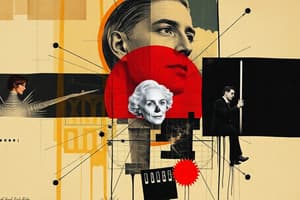Podcast
Questions and Answers
Which statement best describes the primary characteristic of a system?
Which statement best describes the primary characteristic of a system?
- Static collection of unorganized components.
- Isolated objects functioning independently.
- Interacting objects working towards a common goal. (correct)
- Random arrangement with no specific purpose.
What does the system environment primarily consist of?
What does the system environment primarily consist of?
- Internal system processes only.
- System components in isolation.
- Predefined system limitations only.
- External factors influencing the system. (correct)
What mainly influences the decision on where to draw the boundary between a system and its environment?
What mainly influences the decision on where to draw the boundary between a system and its environment?
- The intricacy of its processes.
- The physical dimensions of its parts.
- The existing organizational framework.
- The objectives of the study. (correct)
Which of the following accurately describes an 'attribute' within the context of a system?
Which of the following accurately describes an 'attribute' within the context of a system?
What is best defined as an 'event' within a system?
What is best defined as an 'event' within a system?
From where do endogenous factors affecting a system originate?
From where do endogenous factors affecting a system originate?
Which of the following describes a discrete system?
Which of the following describes a discrete system?
How do state variables change in a continuous system compared to a discrete system?
How do state variables change in a continuous system compared to a discrete system?
What is the main reason for creating a model in simulation?
What is the main reason for creating a model in simulation?
How does a static simulation model represent a system?
How does a static simulation model represent a system?
Which type of simulation involves random variables and probabilistic results?
Which type of simulation involves random variables and probabilistic results?
Why are numerical methods often used over analytical methods in simulation?
Why are numerical methods often used over analytical methods in simulation?
What does 'problem formulation' involve in simulation?
What does 'problem formulation' involve in simulation?
What is meant by 'model translation' in simulation?
What is meant by 'model translation' in simulation?
What is the term for ensuring a simulation has no logical errors and functions correctly?
What is the term for ensuring a simulation has no logical errors and functions correctly?
Which step is essential for verifying a simulation model?
Which step is essential for verifying a simulation model?
What does 'validation' aim to achieve in simulation studies?
What does 'validation' aim to achieve in simulation studies?
What is the focus of experimental design in simulation?
What is the focus of experimental design in simulation?
Which step mainly focuses on getting performance measures from the simulation?
Which step mainly focuses on getting performance measures from the simulation?
What does the final 'implementation' phase of a simulation involve?
What does the final 'implementation' phase of a simulation involve?
How are customers served in a single-channel queuing system?
How are customers served in a single-channel queuing system?
What defines dual-channel queuing systems?
What defines dual-channel queuing systems?
Which probability distribution is commonly used to model customer arrivals in queuing theory?
Which probability distribution is commonly used to model customer arrivals in queuing theory?
What distribution is often assumed for service times in queuing models?
What distribution is often assumed for service times in queuing models?
What is a key assumption of the M/M/1 queuing model?
What is a key assumption of the M/M/1 queuing model?
What does 'reneging' mean in queuing theory?
What does 'reneging' mean in queuing theory?
What does the term 'jockeying' describe in queuing systems?
What does the term 'jockeying' describe in queuing systems?
Which customers are prioritized by the 'First-Come, First-Served' (FCFS) queuing discipline?
Which customers are prioritized by the 'First-Come, First-Served' (FCFS) queuing discipline?
Experimental design in simulation involves decisions on run length and number of replications.
Experimental design in simulation involves decisions on run length and number of replications.
Documentation and reporting are not essential steps in a simulation study.
Documentation and reporting are not essential steps in a simulation study.
Flashcards
System
System
Interacting objects working towards a common goal.
System Environment
System Environment
External factors influencing system operation.
System Boundary
System Boundary
Objectives of the study being conducted.
Attribute
Attribute
Signup and view all the flashcards
Event
Event
Signup and view all the flashcards
Endogenous Factors
Endogenous Factors
Signup and view all the flashcards
Discrete System
Discrete System
Signup and view all the flashcards
Continuous System
Continuous System
Signup and view all the flashcards
Purpose of a Model
Purpose of a Model
Signup and view all the flashcards
Static Simulation Model
Static Simulation Model
Signup and view all the flashcards
Stochastic Simulation Model
Stochastic Simulation Model
Signup and view all the flashcards
Numerical Methods in Simulation
Numerical Methods in Simulation
Signup and view all the flashcards
Problem Formulation
Problem Formulation
Signup and view all the flashcards
Model Translation
Model Translation
Signup and view all the flashcards
Verification
Verification
Signup and view all the flashcards
Verifying a Simulation Model
Verifying a Simulation Model
Signup and view all the flashcards
Validation
Validation
Signup and view all the flashcards
Experimental Design Focus
Experimental Design Focus
Signup and view all the flashcards
Production Runs and Analysis
Production Runs and Analysis
Signup and view all the flashcards
Implementation
Implementation
Signup and view all the flashcards
Single-Channel Queue System
Single-Channel Queue System
Signup and view all the flashcards
Dual-Channel Queue Systems
Dual-Channel Queue Systems
Signup and view all the flashcards
Arrival of Customers
Arrival of Customers
Signup and view all the flashcards
Service Times
Service Times
Signup and view all the flashcards
M/M/1 Queuing Model
M/M/1 Queuing Model
Signup and view all the flashcards
Reneging
Reneging
Signup and view all the flashcards
Jockeying
Jockeying
Signup and view all the flashcards
FCFS (First-Come, First-Served)
FCFS (First-Come, First-Served)
Signup and view all the flashcards
Purpose of Modeling
Purpose of Modeling
Signup and view all the flashcards
Simulation Execution Phase
Simulation Execution Phase
Signup and view all the flashcards
Balking
Balking
Signup and view all the flashcards
Deterministic Simulation Model
Deterministic Simulation Model
Signup and view all the flashcards
Enhancing the Art of Modeling
Enhancing the Art of Modeling
Signup and view all the flashcards
Static Simulation Model
Static Simulation Model
Signup and view all the flashcards
Stochastic Simulation Model
Stochastic Simulation Model
Signup and view all the flashcards
First Phase in Simulation Study
First Phase in Simulation Study
Signup and view all the flashcards
Ensuring the Simulation Model Operates Correctly
Ensuring the Simulation Model Operates Correctly
Signup and view all the flashcards
Confirming Simulation Model Accurately Represents the Real System
Confirming Simulation Model Accurately Represents the Real System
Signup and view all the flashcards
Service in single channel queue
Service in single channel queue
Signup and view all the flashcards
Arrival of Customers in queuing theory
Arrival of Customers in queuing theory
Signup and view all the flashcards
Key assumptions in M/M/1 queue
Key assumptions in M/M/1 queue
Signup and view all the flashcards
Switching: jockeying
Switching: jockeying
Signup and view all the flashcards
Ensuring the Simulation Model Operates without errors
Ensuring the Simulation Model Operates without errors
Signup and view all the flashcards
What is a model?
What is a model?
Signup and view all the flashcards
Dynamic models == specific time.
Dynamic models == specific time.
Signup and view all the flashcards
Verify ensures models operate correctly.
Verify ensures models operate correctly.
Signup and view all the flashcards
Monte Carlo dynamic simulation.
Monte Carlo dynamic simulation.
Signup and view all the flashcards
Reneging == customers leave the queue.
Reneging == customers leave the queue.
Signup and view all the flashcards
Run length and replication design.
Run length and replication design.
Signup and view all the flashcards
Always document for future studies
Always document for future studies
Signup and view all the flashcards
Study Notes
- A system is defined by interacting objects working towards a purpose.
- A system's environment consists of external factors influencing its operation.
- The boundary between a system and its environment is determined by the objectives of the study.
- An attribute is a characteristic or property of an entity within a system.
- An event is an instantaneous occurrence that may alter the system's state.
- Endogenous factors originate from activities and events within the system itself.
- A discrete system is characterized by changes occurring at specific points in time.
- The state variables in a continuous system change smoothly over time.
- The primary purpose of a model in simulation is to simplify the system for easier analysis.
- A static simulation model represents a system at a single point in time.
- A stochastic simulation model incorporates random variables and probabilistic outcomes.
- Numerical methods are preferred over analytical methods because they can handle more complex models.
- "Problem formulation" involves defining project objectives and scope.
- "Model translation" refers to transforming the conceptual model into a computer program.
- Ensuring the simulation model is free from logical errors and functions correctly is known as verification.
- Debugging code for correct input parameters is crucial for verifying a simulation model.
- "Validation" aims to confirm that the model accurately represents the real system.
- Experimental design focuses on determining the length of simulation runs and the number of replications.
Simulation Study Phases
- "Production runs and analysis" focuses on obtaining performance estimates from the simulation model.
- The "implementation" phase involves applying the simulation results to real-world decisions.
Queuing Models
- In a single-channel queue system, customers are served one at a time by a single server.
- Dual-channel queue systems are characterized by two servers operating independently.
- The arrival of customers is often modeled with a Poisson distribution.
- Service times are commonly assumed to follow an exponential distribution.
- A key assumption of the M/M/1 queuing model is an infinite queue capacity.
- "Reneging" refers to customers leaving the queue before receiving service.
- "Jockeying" describes customers switching between queues.
- "First-Come, First-Served" (FCFS) prioritizes customers in the order of their arrival.
- Model translation is the phase where a model is executed to obtain results during production runs.
- ‘Balking’ refers to customers deciding not to join the queue.
- A deterministic simulation model contains no random variables and outputs are predictable.
- The art of modeling is enhanced by the ability to abstract essential features of a problem.
- Problem formulation is the first phase in a simulation study.
- Verification ensures that the simulation model operates correctly.
- Simulation models are representations of a system used to study its behavior - this statement is true.
- Dynamic simulation models represent systems at a specific point in time - this statement is false.
- Verification ensures that the simulation model operates correctly - this statement is true.
- Monte Carlo simulation is a type of dynamic simulation model - this statement is false.
- Experimental design in simulation involves decisions on run length and number of replications - this statement is true.
- Documentation and reporting are not essential steps in a simulation study - this statement is false.
Studying That Suits You
Use AI to generate personalized quizzes and flashcards to suit your learning preferences.




